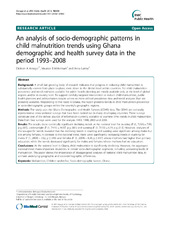An analysis of socio-demographic patterns in child malnutrition trends using Ghana demographic and health survey data in the period 1993-2008
Peer reviewed, Journal article
Published version
Permanent lenke
https://hdl.handle.net/1956/7578Utgivelsesdato
2013-10-16Metadata
Vis full innførselSamlinger
Originalversjon
https://doi.org/10.1186/1471-2458-13-960Sammendrag
Background A small but growing body of research indicates that progress in reducing child malnutrition is substantially uneven from place to place, even down to the district level within countries. Yet child malnutrition prevalence and trend estimates available for public health planning are mostly available only at the level of global regions and/or at country level. To support carefully targeted intervention to reduce child malnutrition, public health planners and policy-makers require access to more refined prevalence data and trend analyses than are presently available. Responding to this need in Ghana, this report presents trends in child malnutrition prevalence in socio-demographic groups within the country’s geographic regions. Methods The study uses the Ghana Demographic and Health Surveys (GDHS) data. The GDHS are nationally representative cross-sectional surveys that have been carried out in many developing countries. These surveys constitute one of the richest sources of information currently available to examine time trends in child malnutrition. Data from four surveys were used for the analysis: 1993, 1998, 2003 and 2008. Results The results show statistically significant declining trends at the national level for stunting (F (1, 7204) = 7.89, p ≤ .005), underweight (F (1, 7441) = 44.87, p ≤ .001) and wasting (F (1, 7130) = 6.19, p ≤ .013). However, analyses of the sex-specific trends revealed that the declining trends in stunting and wasting were significant among males but not among females. In contrast to the national trend, there were significantly increasing trends in stunting for males (F (1, 2004) = 3.92, p ≤ .048) and females (F (1, 2004) = 4.34, p ≤ .037) whose mothers had higher than primary education, while the trends decreased significantly for males and females whose mothers had no education. Conclusions At the national level in Ghana, child malnutrition is significantly declining. However, the aggregate national trend masks important deviations in certain socio-demographic segments, including worsening levels of malnutrition. This paper shows the importance of disaggregated analyses of national child malnutrition data, to unmask underlying geographic and socio-demographic differences.
Utgiver
BioMed CentralOpphavsrett
Copyright 2013 Amugsi et al.; licensee BioMed Central Ltd.Dickson A Amugsi et al.; licensee BioMed Central Ltd.

